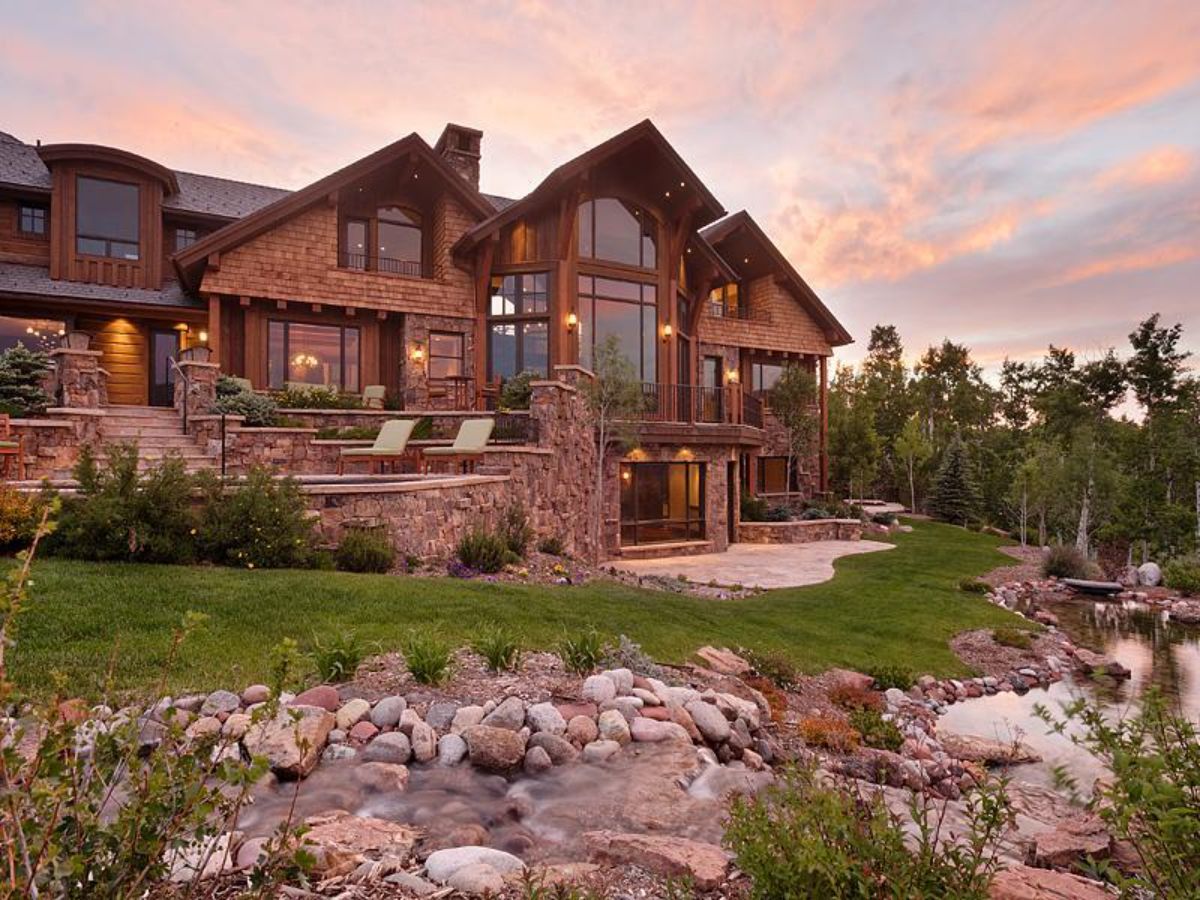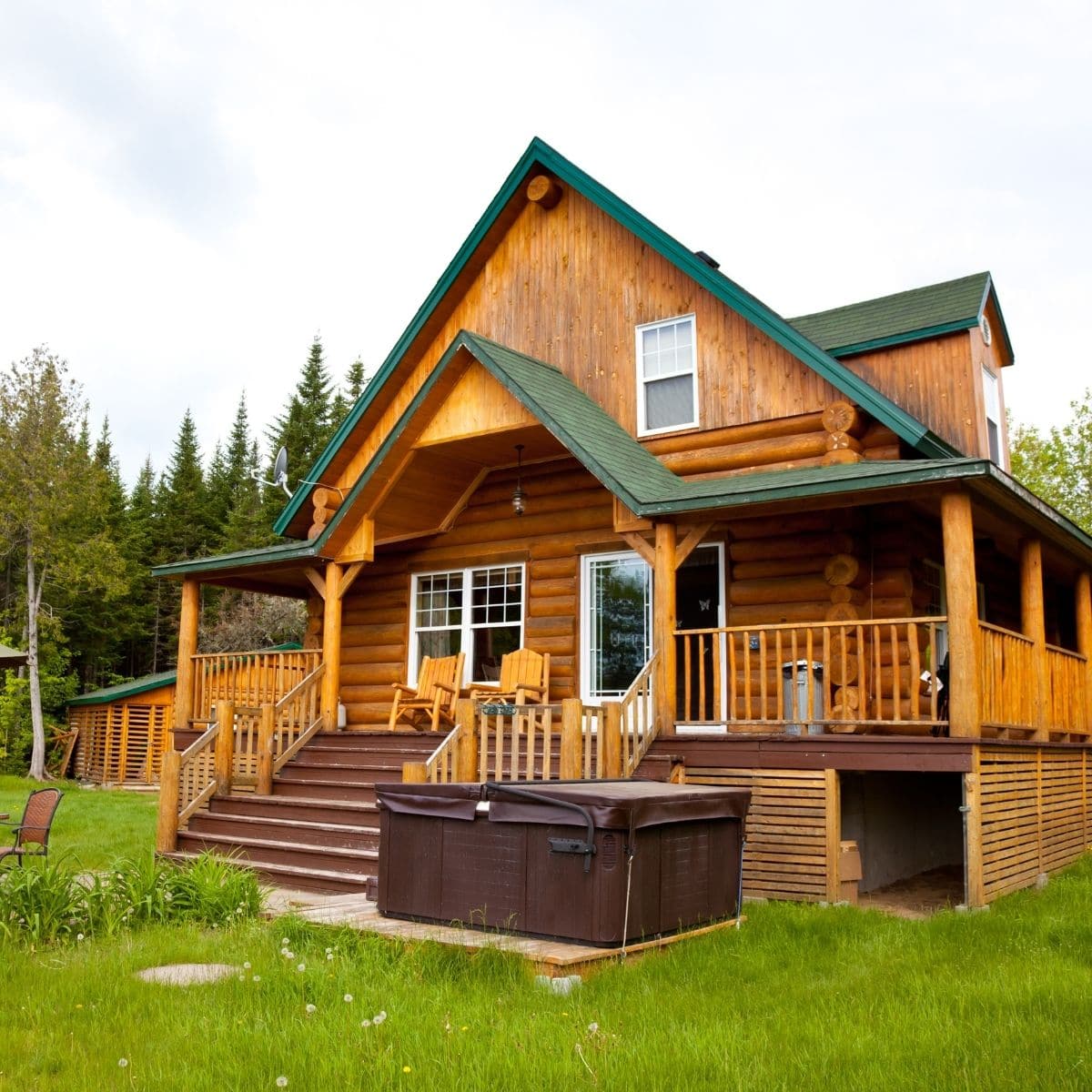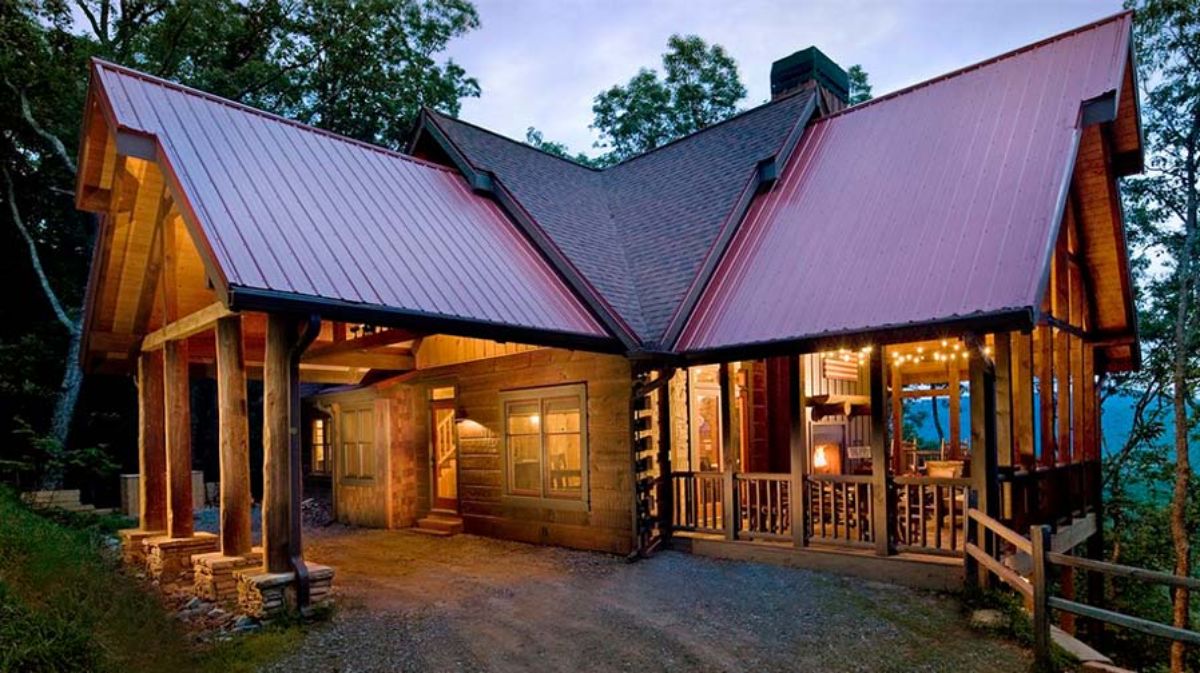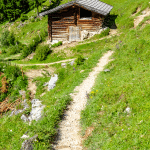Below we’ve included some log cabin FAQs that may answer some of your own questions about log cabins, timber frame homes, rustic building techniques and construction in general.
(1) What type of wood is best for log homes?
No one wood is the best for use in a log home. In addition to the various log styles, there are many different wood species used in cabins. One of the most commonly used woods is Eastern white pine because it’s plentiful, easy to work and looks beautiful. Other woods have their own unique characteristics:
- Oak is strong and heavy, with a tight grain.
- Western Red cedar has natural resistance to bugs and decay, is very easy to work with and has a gorgeous color and grain when finished but isn’t very strong for beams.
- Englemann spruce is very straight with not much taper, light in color with a touch of red; the logs are lighter weight but have good thermal characteristics.
- Douglas fir is very strong with good fungal and mildew resistance. It is excellent for structural beams and logs.
- Lodgepole pine needs to be treated for decay resistance but is straight-grained and yellowish in color.
The best answer is to use whatever is most common in the area where you are building. The local builders will be more accustomed to working with that species and being native, the logs have adapted to your climate conditions. Best of all you’ll save money by not having to pay expensive shipping charges.
| Do you have a question for Log Cabin FAQs? Please contact us directly and we'll respond as quickly as possible. |
(2) Do the logs need to be dried?
Log homes can be built with green wood that has not been dried but care must be taken to deal with the inevitable shrinking and settling that result. Log home companies are adept at this and have many different ways of handling these issues. It’s especially important around door and window bucks and at corners. Some companies even utilize steel rods through the logs with 1000-lb springs to keep the logs tightly joined together.
The other way to build is with logs that have been dried and this can be done in different ways. The logs can be harvested in the winter when the sap is down and then air-dried for a year or more. It’s recommended that the moisture content be less than 20% to ensure minimal shrinking and settling.
Oftentimes log companies will only harvest standing dead wood. These are trees that have been killed by a forest fire but not burned up. They are still standing which means they are not rotten, and they are being used in a sustainable fashion.
Finally, logs can be kiln-dried, where they are placed in giant ovens and baked until the moisture content is down to an acceptable level and any shrinkage or movement is minimized.
| Do you have a question for Log Cabin FAQs? Please contact us directly and we'll respond as quickly as possible. |
(3) How much does it cost to buy a log home kit?
These prices can vary considerably based on what sort of log home package you’re getting (what’s included), location, type of logs used, the profile of the log, corner system, etc.
Typical log shells run in the $20-$80/sq.ft. range, dry-in packages may be $70-$150/sq.ft. and complete kits or turn-key packages can be $110-$250/sq.ft. and on up. Log cabin kit prices vary depending on an array of choices including flooring, fixtures, kitchen cabinets and so on.
Bear in mind that using square-foot prices alone can be misleading as log homes are unique and the floor plans and options you select will play a large role in the final price. Likewise, the location of your build will affect the cost as local labor and cost of materials to finish the cabin will vary by location.
Check out our page on cheap log home kits for tips and ways to save money on your log cabin package.

The prices quoted generally do not include buying land, installing utilities, septic system or hook-up to existing sewer, wells or hook-up to existing water system, or excavation. In some parts of the country where rock is prevalent, it may even be necessary to blast your foundation out of solid rock and the costs can add up considerably.
It’s important to establish exactly what is included or not; for example, outdoor rooms such as decks, outdoor kitchens, porches or a garage.
As a very rough rule, log homes typically cost about 10%-20% more than a conventionally framed house to build. Wiring log cabins and the routing of plumbing systems can complicate the build, and finding skilled labor can also cost more.
It’s difficult to isolate the additional costs because the average person who wants a log home also wants high cathedral ceilings, a large fireplace wrap-around porches, careful siting in difficult-to-access locations and rustic cabin decorations or unique fittings and fixtures. All of these of course come with a higher price tag and can skew the “typical” price of a log home.
| Do you have a question for Log Cabin FAQs? Please contact us directly and we'll respond as quickly as possible. |
(4) Are log homes energy efficient?
Log homes can be as much as 15% more energy efficient than conventional stick-framed houses, thanks to the thermal mass effect. Briefly, the “thermal mass” of a log home means that the logs can store heat and release it back slowly over time, contributing to the energy efficiency.
In addition, there are a myriad of details during the build that can contribute to the overall efficiency in significant ways. Check out our page on the energy efficiency of log homes for more information on this. Or look up tips for building an energy-efficient log home.
| Do you have a question for Log Cabin FAQs? Please contact us directly and we'll respond as quickly as possible. |
(5) What’s the most inexpensive way to build a log cabin?
The single item with the biggest impact on cost is the basic design of the cabin. Check out our page on log cabin design for more tips and ways to save money.
The simplest and therefore cheapest design is a cabin with 4 square corners. Adding extra corners increases the work and cost starting from the foundation, through setting logs, to roof framing and cabin roofing itself.
It’s better to keep the design simple and straightforward and put your money into making each element of your log home right and beautiful.
Use stock log home floor plans and materials. Anything custom will increase costs dramatically and may not be unique enough to warrant the added expense.
Stick with standard kitchen cabinets and bathroom cupboards, efficient cabin windows and doors, and conventional roofing systems rather than log systems (or consider using structural insulated panels) and you’ll save money on your cabin design.
| Do you have a question for Log Cabin FAQs? Please contact us directly and we'll respond as quickly as possible. |
(6) Are log homes maintenance-free?
No homes are maintenance-free. Log homes require no more maintenance than a conventionally-framed house with wood siding, though. It’s a good idea to take a walk around your log home twice a year, in the spring and in the fall and evaluate your exterior.
Check out our spring maintenance tips page or our cabin maintenance page for more comprehensive information about what to watch out for and the best ways to deal with keeping your cabin like new.
Wood is a dynamic thing and it will move with the weather. It expands and contracts, it absorbs moisture and gives off moisture. Over time you will need to re-caulk joints and checks or cracks as they appear, apply fresh coats of log stain or sealer to your logs and ensure that bushes and shrubbery don’t get too close to your logs and hold moisture.
Our log home landscaping page has more tips on how to minimize maintenance issues with proper landscaping techniques.
| Do you have a question for Log Cabin FAQs? Please contact us directly and we'll respond as quickly as possible. |
(7) Is insurance for a log home more expensive than for a conventional home?
No. The cost of your insurance is more about your claim history, where your cabin is located and how far away the fire protection service is.
Log homes have survived in areas hit by forest fires because the logs are so thick they either don’t burn or burn very slowly. Imagine trying to start a campfire with logs. In a stick-framed house a fire can use the stud bays (the area between the studs) like a fireplace flue and burn upward unimpeded.
Log home lenders are familiar with the difference between conventional construction and building a log cabin. They offer log home insurance across the country.
| Do you have a question for Log Cabin FAQs? Please contact us directly and we'll respond as quickly as possible. |
(8) What if I don’t want all round logs inside and out?
No problem. Milled logs are available in a variety of shapes, one of the most common of which is the “D” log. This name comes from the fact that the outside is rounded and the inside is flat. This way you get the round log look outside but it’s easier to hang cabinets and pictures and to clean inside with the flat side of the log.
In addition to the "D" log shape, you can also choose square or beveled or even install log siding to the outside of a conventionally-framed house to create the log cabin look.
Read our page on log styles for more information.
| Do you have a question for Log Cabin FAQs? Please contact us directly and we'll respond as quickly as possible. |
(9) How are log homes wired?
We run the first two courses of logs, and then lay out all the outlets for electric, phone and cable TV or fiber-optic. We drill down through the two courses and through the sub-floor and run the wiring under the sub-floor/in the basement ceiling to the main electrical panel. Interior walls are typically framed and wired conventionally.
For more information check out our page on wiring log cabins.
| Do you have a question for Log Cabin FAQs? Please contact us directly and we'll respond as quickly as possible. |
(10) Can I have any kind of roofing that I want?
Certainly. From the viewpoint of log home building, the cabin roofing material doesn’t matter. We normally use metal roofs since they have much longer life spans, look great with the logs and generally earn the homeowner a reduced insurance premium due to the metal roofs having higher safety in a fire.
You can save construction time and therefore money using a rigid panel roof system like structural insulated panels or SIPs.

| Do you have a question for Log Cabin FAQs? Please contact us directly and we'll respond as quickly as possible. |
(11) How do you seal the log joints?
We use milled logs with a double tongue-and-groove system. This gives two interlocking joints to ensure precise placement and a weather tight fit. In addition, we install a line of expanding foam in these grooves as we set the logs to totally seal out any air infiltration.
Another method of sealing the logs is to use chinking -- a flexible sealant applied to the outside of the joint between the logs.
| Do you have a question for Log Cabin FAQs? Please contact us directly and we'll respond as quickly as possible. |
(12) What if I want a basement?
No problem, depending on the topography of the land. Log homes in western North Carolina (where we build) are generally built on a slope anyway and can easily accommodate a walk-out basement.
A great way to save money is to have your basement roughed-in for electrical and plumbing initially, then you can finish it out later when you have the money.
| Do you have a question for Log Cabin FAQs? Please contact us directly and we'll respond as quickly as possible. |
(13) Are there log home building schools that can help teach me all of this?
There are indeed log home building schools located in various places around the US and elsewhere.
Check out our page on Log Home Building Schools for more information and contacts.
These places offer practical, hands-on experience that is invaluable. Even if you decide to hire a crew to build your log home kit you will be equipped with the knowledge and understanding of the tasks involved and decisions that are required to be made.
| Do you have a question for Log Cabin FAQs? Please contact us directly and we'll respond as quickly as possible. |
(14) What is a sleeper log?
The term sleeper is used in construction to refer to a support - railroad ties are called sleepers, for example.
In log cabin construction a sleeper log would typically be used as a floor support under the joists, but without being notched out. The joists would lay on top.
| Do you have a question for Log Cabin FAQs? Please contact us directly and we'll respond as quickly as possible. |
(15) I'm having trouble running my electrical - the holes drilled in the logs don't line up.
Running wire often involves getting creative! Here are some ideas that may help:
- Re-drill the holes using a long fish bit so they do line up
- Do you have access to at least one side that you could re-drill with a larger diameter so you hit the other hole?
- Drill into the point in the logs where the holes for the wires don't meet using a large Forstner bit, cut a recess pocket, pull the wires out and join them in a junction box set into the pocket
- Add an outlet in the recess pocket and use that as a junction point
- Rout a groove along a log to run the wire and cover that later with trim or even fill it in with another piece of wood cut to fit.
- Bypass that section and run the wires via another route
| Do you have a question for Log Cabin FAQs? Please contact us directly and we'll respond as quickly as possible. |
(16) Is there a minimum spacing required between my wood-burning fireplace and the mantel or other wood above it?
You need to check your local building codes with regard to cabin fireplaces and fireplace mantels. This is subject to National Fire Code and Building Code.
National Fire Code:
The National Fire Code dictates that any combustible material (e.g., wood mantel or similar trim) must be at least six inches from the firebox opening. An additional inch of clearance is needed for every 1/8 inch the combustible material or trim protrudes.
National Standard Building Code:2114.3 Masonry-built Fireplaces 4114.3.10 - All combustible mantels and similar trim shall be kept at least 6 inches from the fireplace opening. Parts of the mantel assembly located along the sides of the fireplace opening which project more than 1 1/2 inches (38mm) from the face of the fireplace shall have additional clearance equal to the projection extension beyond 1 1/2 inches. Parts of the mantel assembly located above and projecting more than 1 1/2 inches (38mm) from the fireplace opening shall not be placed less than 12 inches (305mm) from the top of the fireplace opening.
| Do you have a question for Log Cabin FAQs? Please contact us directly and we'll respond as quickly as possible. |
(17) How do I flash a ledger board for a lean to I want to install on the gable end of my full-round log cabin?
To flash a ledger board on a full-round log home we will normally cut a line into the logs using a circular saw and slip the flashing into the slit, bedding it in silicone.
Make sure you have a good angle on the flashing so the water runs off and down the roof instead of back against the log wall.
| Do you have a question for Log Cabin FAQs? Please contact us directly and we'll respond as quickly as possible. |
(18) What type of connection or Simpson Strong-Tie do you recommend for engineered roof trusses to connect to the top of log walls? The regular RT7 hurricane ties would show on the inside walls of a D-log home. Toenailing alone does not provide the live loads I would like.
Simpson Strong-Tie HD3BHDG would work, by driving a 14" log screw vertically down through the top of the log wall. Or any sort of right angle bracket that would accommodate a log screw rather than the standard galvanized hanger nails.
| Do you have a question for Log Cabin FAQs? Please contact us directly and we'll respond as quickly as possible. |
(19) I want to build a log cabin but I don't have much money. What's the cheapest way to do it?
The cheapest way is to build your log cabin yourself. We talk about building cabins here:
But it all starts with proper design:
And keeping your cabin small so you don't waste space and money:
| Do you have a question for Log Cabin FAQs? Please contact us directly and we'll respond as quickly as possible. |
(20) We have just built a new log cabin kit and I've been amazed by the amount of dust everywhere - all the time. Do new log cabins eventually settle down and not shed so much dust? I can run a rag across my furniture and 10 mins later it has dust on it again! Should I do some kind of sweeping on the internal walls?
That amount of dust doesn't sound right. Cabins are not inherently more dirty or dusty. I suspect that the builders didn't cover the vents and air ducts when they were building. You should try pulling off the air vents and sweeping or vacuuming the ducts as far as you can reach. Then you may need to replace your air filter several times as it filters the air.
| Do you have a question for Log Cabin FAQs? Please contact us directly and we'll respond as quickly as possible. |
(21) What's the best way to handle termites in our log home?
You can read more on our termites page, but basically you have several options for dealing with termites effectively:
- Spray logs or wood with Termidor termicide. This is primarily for outdoor use but can also be used indoors for spot treatment of termites.
- If you don't already have a portable sprayer, I would recommend one of these for easy mixing and application. This is good for covering large areas.
- An alternative for smaller areas or overhead work, is to use Termidor foam. This clings to logs better and fills cavities, but is impractical for large areas.
- Finally, I would follow up outside with Spectracide termite killing stakes. You simply drive these in the ground. Each stake covers about 120-200 sq.ft.

| Do you have a question for Log Cabin FAQs? Please contact us directly and we'll respond as quickly as possible. |
(22) What's the best way to clean my exterior logs before I re-stain them?
The best thing for light cleaning prior to staining is simply hosing down the exterior logs. Brush with a soft brush using a soap solution (dish soap or detergent) and rinse clean.
Check out our maintenance page for more details:
https://log-cabin-connection.com/fall-cabin-maintenance.html
For more heavy-duty cleaning you may need to use a pressure washer. Check out our cabin restoration page for more:
https://log-cabin-connection.com/cabin-restoration.html
| Do you have a question for Log Cabin FAQs? Please contact us directly and we'll respond as quickly as possible. |
(23) We have some peculiar new spots showing up on our cabin. They are yellowish in color and tend to be around knots in the logs. I was hoping you could help me to identify these and possibly fix?
It sounds like sap or resin from the logs is seeping out due to the heat. Some logs that weren't well-seasoned contain small pockets of resin or pitch and when the logs heat up in the sun they weep out the sap.
Unfortunately there isn't any good fix for this. You can try wiping small spots with a thinner, like alcohol, but be careful of the surrounding finish. If you wait until cold weather (if you have cold weather where you are) you can scrape it off easier.
More Log Home Education Pages:
Log Cabin Glossary Defines Common Terms This log cabin glossary defines and explains many common terms encountered when researching log homes and cabins.
Get a Log Home Education Getting a log home education involves utilizing the many cabin resources available.
9 Interesting Facts About Log Cabins Think you know all about log homes? Learn these 9 interesting facts about log cabins.
How to Renovate a Heritage Log Cabin Interior - DIY Style See how one family learned how to renovate a heritage log cabin interior - DIY style in British Columbia.
Restoring a Heritage Log Cabin Read this account of restoring a heritage log cabin as a labour of love in British Columbia.


Leave a Reply